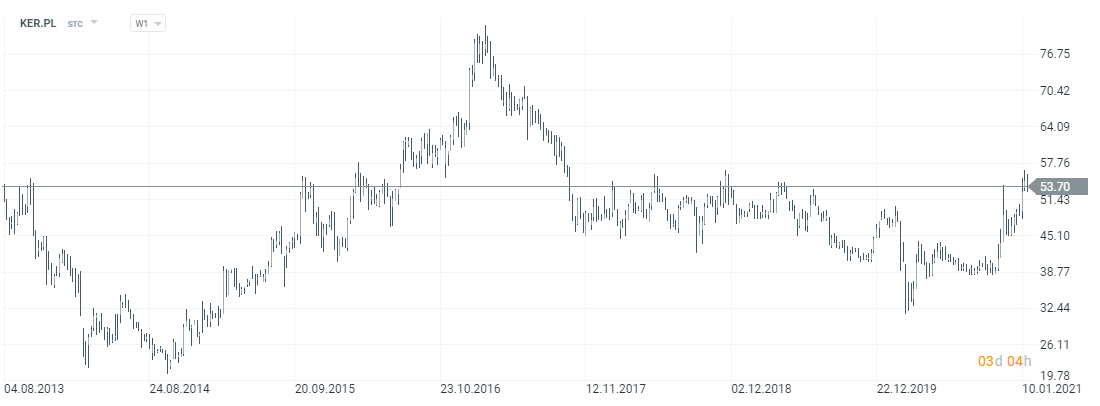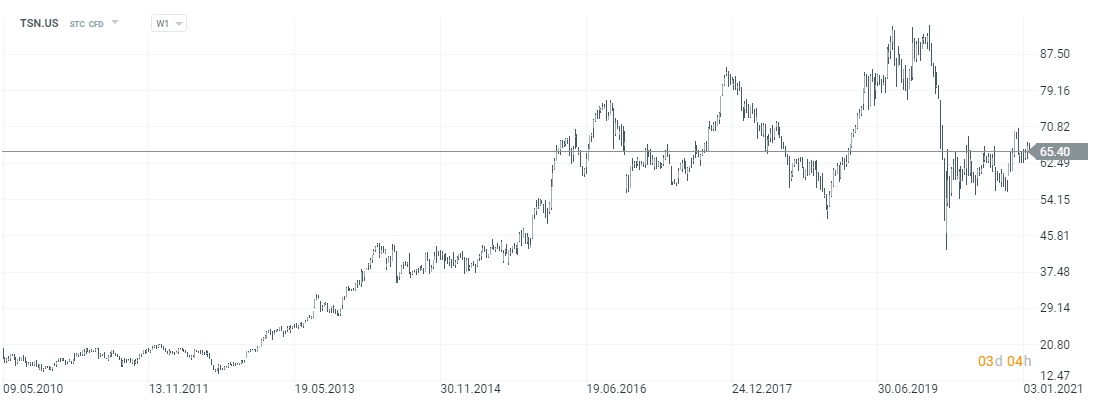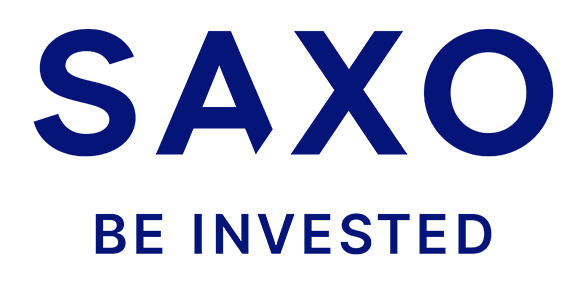The food market, or how to invest in food - ETN, ETF, REIT [Guide]
How to insure against the risk of losing the purchasing power of money? One idea is to replace depreciating cash with another asset class. Ideally, your investment portfolio should be diversified to reduce risk. One of the ideas worth investing some free funds in are assets related to the food market. Of course, as an element of the "mix" in the investor's assets.
The food market is an interesting idea to invest. Some billionaires diversify their wealth by purchasing arable land. An example would be Bill Gates, who recently became the largest farmland owner in the United States. It has over 242 acres of arable land spread over 18 states.
There are many ways to invest in the food market. Buying good-quality agricultural land (for lease or for speculative purposes) requires a lot of money. At the same time, such an investment is highly geographically concentrated (e.g. one commune). You don't necessarily have to buy arable land to be exposed to the food market. Investments in food related assets can be achieved through:

Soybean chart, interval W1. Source: xNUMX XTB.
- Another idea is to acquire food manufacturing companies. An example of such a company is the Ukrainian Kernel, which produces sunflower oil and sells sunflower meal. Another company listed on the WSE, which is related to the market of food raw materials is the Ukrainian Astart, which produces sugar. It should be remembered that investing in individual raw material companies should be preceded by a prior analysis of the enterprise. This is due to the fact that ineffective management may not take advantage of the good economic situation on a given raw material market.

Kernel stock chart, interval W1. Source: xNUMX XTB.
- Another idea is to buy an ETF, ETC, ETN or REIT with exposure to this market segment.
Be sure to read: How to invest in raw materials, metals and agricultural goods [Guide]
ETN
Quite often, you can invest in the market of food raw materials using ETNs. The ETN is a publicly traded unsecured debt security. Like most debts, it has a maturity date. The mechanism of action is simple. During the ETN issue, its issuer undertakes to repay the principal on the redemption date. An ETN does not invest "directly" in a particular asset class. The ETN buyer gets a "synthetic" exposure to the market through a benchmark which is some kind of independent index. The return on the index is reflected in the ETN rate (less the management fee). When purchasing an ETN, an investor exposes himself to two risks: credit risk (issuer's bankruptcy) and market risk (change in the market price of the asset).
An example of an ETN is the RICI-Agriculture ETN (RJA), which was established in 2007 and expires in October 2022. The issuer of ETN is Swedish Export Credit Corporation, and the benchmark is Rogers International Commodity Index - Agriculture Total Return. The annual ETN management fee is 0,75%.
Creator of indices from the Rogers International Commodity Index group (RICI®) is legendary investor in the commodities market James B. Roger. In Poland, known mainly from the book "Czarodzieje Rynku" (Market Wizards: Interviews with Top Traders) by Jack Schwager.
The Rogers International Commodity Index - Agriculture Total Return represents the "agricultural" basket. According to the data presented on the RICI website® said index consists of 22 components. The largest share in the index is held by:
- Corn - 13,6%
- Cotton - 12,0%
- Soybeans - 10%
- "Soft Red" grade wheat - 7,9%
- Coffee - 5,7%
- Live cattle - 5,7%
It is worth mentioning that this index also includes gum (2,9%), rapeseed (2,9%) and orange juice (1,7%). So it is a very diversified index. Despite the huge diversification, the investment in RICI-Agriculture ETN did not bring any profit in the long term. Since its debut, the ETN has lost over 33% of its value.
REIT
According to data collected by the USDA (US Department of Agriculture), there are 897 million acts of arable land in the United States (data for 2019). The average size of the farm does not exceed 444 acres (over 176 hectares). Farmers and ranchers own approximately 61% of the land. The rest is leased from external owners. About 10% of the land is owned by corporations, trusts or funds.
Read: What is a REIT and how can you invest in it [Guide]
The stock exchange also offers investments in companies that lease their land to farmers. Such companies benefit from rising raw material prices as it improves the financial situation of tenants (farmers). The business model of leasing their land to farmers is an interesting solution for REITs. Investor. by buying stocks of such companies, he has exposure to agricultural real estate in the United States. The disadvantages of such a solution include exposure to credit risk, quality of the management board or currency risk.
There are REITs on the American stock exchange that carry out this type of business.
Farmland Partners Inc. (FPI)
The REIT owns approximately 156 acres spread over 500 farms spread across 340 states. The company has over 16 tenants paying approximately $ 100 million annually. Farmland has valued its assets at approximately $ 50 billion
Gladstone Land Corporation (COUNTRY)
A REIT of approximately 90 acres spread across 000 farms spread across 127 states. The company focuses on land for specialized crops (eg vegetables, fruit), as opposed to Farmland, which focuses on "traditional" crops (cereals, soybeans). The land is valued at approximately $ 13 billion. The company states that the profitability of renting land for renting specialized crops is much higher than the "traditional" ones.
ETF
If an investor does not want to acquire shares only in the raw materials market, he can benefit from investing in industries related to the food industry. The sectors related to food raw materials include fertilizer producers, sellers of medicines for animals and producers of agricultural equipment. All these companies benefit from the boom in agribusiness. An interesting example is Vaneck Vectors Agribusiness ETF (MOO)that invests in companies of this type. MOO has approximately $ 950 million in assets under management (AUM). The management fee for this fund is 0,56% per annum. The benchmark for the ETF is the MVIS Global Agribusiness Index.
The biggest positions in this ETF are:
- Deere & Company - producer of agricultural machinery,
- Zoetis - producer of medicines and vaccines for animals,
- Bayer - a chemical company that also produces fertilizers, owns Monsanto (seeds, plant protection chemicals),
- Idexx Laboratories - laboratories and analyzers, have a segment (CAG) dedicated to offering testing and analysis solutions for animals (e.g. blood tests),
- Nutrien - producer of fertilizers (phosphates, potassium, nitrogen),
- Corteva - producer of plant protection products,
- Archer-Daniels-Midland Company - they deal with purchasing, storing and transporting seeds. It produces, among others sweetening syrups or feed gluten.
Another example of an ETF related to the food commodity market is Ishares agibusiness ucits etf (isag.uk). The fund has assets under management of $ 96 million. The annual fee (TER) is 0,55%. The ETF is benchmarked with the S&P Commodity Producers Agribusiness Index. ISAG invests in companies that are related to the agricultural sector. These include producers of agricultural machinery (Deere), fertilizers (Nutrien) or food producers (Tyson Foods - meat industry).

IShares Agribusiness UCITS ETF Chart (ISAG.UK), Interval W1. Source: xNUMX XTB.
ETC - Exchange Traded Commodity
ETC stands for Exchange Traded Commodity. The aim of the ETC is to replicate a given benchmark as faithfully as possible. The ETC, like the ETN, is a debt instrument. Debt can be secured or unsecured. In the case of secured debt, ETC invests capital in a specific asset (e.g. copper) which is held by the depositary. ETC often uses mapping through swap contracts (secured or unsecured). The risk of investing in such an ETC is credit risk, counterparty risk (swap default).
As an example of ETC in the food market is WisdomTree Agriculture, which is listed on the London, Frankfurt, Milan, Tokyo and the Euronext exchange alliance. Over £ 143 million is raised under this fund. The management fee is 0,49% per annum and an additional annual fee for servicing the swap (0,45% or 0,001233% per day). The ETC benchmark is the Bloomberg Agriculture SubIndex. The ETC uses imitation through a swap contract that is hedged.
Commodity pool
Another idea to invest in the raw materials market is to take advantage of the offer Commodity pool. These are investment structures that allow investors to participate in futures trading on the futures market. The phrase "commodity pool" is a term precisely defined by the NFA (National Futures Association).
One example is Tecrium Soybean (Soyb)who invests accumulated funds only in soybean futures. SOYB was founded in 2011 and has accumulated over $ 90 million in assets under management. The costs of participating in the commodity pool are significant. They reach as much as 2,5% per year. Therefore, this instrument is suitable for short-term trading (contract substitute) rather than a tool for the long-term investor. The 5-year average annual rate of return on the fund was only 2,2%.
Invest in raw materials or raw material companies?
Investing in raw materials can be a good protection against inflation. It should be remembered that the commodity market is highly dependent on weather factors (harvest defeat, crop failure) and the strength of the dollar. The weaker the dollar, the more favorable the environment for rising commodity prices. Investing in commodities may be preferred by short- and medium-term investors. Long-term investors, on the other hand, usually prefer to invest in a raw material company rather than the raw material itself.
The main problem in investing in non-cash-generating assets is how to properly value them. As a rule, production costs are the long-term "floor", but in the raw material market there are situations of oversupply, which can push the price below the cost of production. Another problem with investing in raw materials is the lack of compound interest. A company that can scale its business is able to generate an increasing amount of free cash (FCF), which it can use for further development or to buy shares or pay dividends. Tyson Foods is an example of such a company related to the food industry. Over the last 10 years, the rate of return on investment in the company has exceeded 300%.
Selected financial data of Tyson Foods
| Tyson Foods | 2011 | 2015 | 2020 |
| revenues | $ 32 million | $ 41 million | $ 43 million |
| Operational profit | $ 1 million | $ 2 million | $ 3 million |
| Operating margin | 4,02% | 5,96% | 8,89% |
| Net profit | $ 750 million | $ 1 million | $ 2 million |
| Earnings per share (EPS) | $ 1,80 | $ 3,32 | $ 5,77 |
| Dividend per share | $ 0,16 | $ 0,40 | 1, 68 $ |

Tyson Foods stock chart, interval W1. Source: xNUMX XTB.
Where to invest in ETFs and stocks
An increasing number of forex brokers have quite a rich offer of stocks, ETFs and CFDs for these instruments.
For example on XTB Today, we can find over 3500 equity instruments and 400 ETFs, a Saxo Bank over 19 companies and 000 ETF funds.
| Broker |  |
 |
 |
| End | Poland | Denmark | Cyprus * |
| Number of exchanges on offer | 16 exchanges | 37 exchanges | 24 exchanges |
| Number of shares in the offer | approx. 3500 - shares circa 2000 - CFDs on shares |
19 - shares 8 - CFDs on shares |
approx. 3 - CFD on shares |
| The amount of ETF on offer | approx. 400 - ETF approx. 170 - CFD on ETF |
3000 - ETF 675 - CFD on ETF |
approx. 100 - CFD on ETF |
| Commission | 0% commission up to EUR 100 turnover / month | according to the price list | Spread depends on the instrument |
| Min. Deposit | PLN 0 (recommended min. PLN 2000 or USD 500, EUR) |
0 PLN / 0 EUR / 0 USD | PLN 500 |
| Platform | xStation | SaxoTrader Pro Saxo Trader Go |
Plus500 platform |
* PLUS500 CY offer
CFDs are complex instruments and come with a high risk of losing money rapidly due to leverage. From 72% to 89% of retail investor accounts record monetary losses as a result of trading CFDs. Think about whether you understand how CFDs work and whether you can afford the high risk of losing your money.






















![Forex Club – Tax 9 – Settle tax on a foreign broker [Download the Application] Forex Club - Tax 9](https://forexclub.pl/wp-content/uploads/2024/02/Forex-Club-Podatek-9-184x120.jpg?v=1709046278)
![Trading View platform – solutions tailored to the needs of traders [Review] trading view review](https://forexclub.pl/wp-content/uploads/2024/03/trading-view-recenzja-184x120.jpg?v=1709558918)
![How to connect your FP Markets account to the Trading View platform [Guide] fp markets trading view](https://forexclub.pl/wp-content/uploads/2024/02/fp-markets-trading-view-184x120.jpg?v=1708677291)
![How to invest in ChatGPT and AI? Stocks and ETFs [Guide] how to invest in chatgpt and artificial intelligence](https://forexclub.pl/wp-content/uploads/2023/02/jak-inwestowac-w-chatgpt-i-sztuczna-inteligencje-184x120.jpg?v=1676364263)


![WeWork – the anatomy of the collapse of a company valued at $47 billion [WeWork, part II] wework bankruptcy story](https://forexclub.pl/wp-content/uploads/2024/04/wework-bankructwo-historia-184x120.jpg?v=1711729561)
![Adam Neumann – the man who screwed up Softbank [WeWork, part AND] adam neumann wework](https://forexclub.pl/wp-content/uploads/2024/04/adam-neumann-wework-184x120.jpg?v=1711728724)





![How to transfer shares to another brokerage office [Procedure description] how to transfer shares to another brokerage house](https://forexclub.pl/wp-content/uploads/2024/03/jak-przeniesc-akcje-do-innego-biura-maklerskiego-184x120.jpg?v=1709556924)

![The most common mistakes of a beginner trader - Mr Yogi [VIDEO] Scalping - The most common mistakes of a beginner trader - VIDEO](https://forexclub.pl/wp-content/uploads/2024/03/Scalping-Najczestsze-bledy-poczatkujacego-tradera-VIDEO-184x120.jpg?v=1711601376)
![Learning patience: No position is also a position - Mr Yogi [VIDEO] Scalping - Learning patience - No position is also a position - VIDEO](https://forexclub.pl/wp-content/uploads/2024/03/Scalping-Nauka-cierpliwosci-Brak-pozycji-to-tez-pozycja-VIDEO-184x120.jpg?v=1710999249)
![When to exit a position and how to minimize losses - Mr Yogi [VIDEO] Scalping - When to exit a position and how to minimize losses - VIDEO](https://forexclub.pl/wp-content/uploads/2024/03/Scalping-Kiedy-wyjsc-z-pozycji-i-jak-minimalizowac-straty-VIDEO-184x120.jpg?v=1710336731)


![The food market, or how to invest in food - ETN, ETF, REIT [Guide] food market investing in food](https://forexclub.pl/wp-content/uploads/2021/01/rynek-spozywczy-inwestowanie-w-zywnosc.jpg?v=1611839412)

![How to invest in ChatGPT and AI? Stocks and ETFs [Guide] how to invest in chatgpt and artificial intelligence](https://forexclub.pl/wp-content/uploads/2023/02/jak-inwestowac-w-chatgpt-i-sztuczna-inteligencje-300x200.jpg?v=1676364263)


![The food market, or how to invest in food - ETN, ETF, REIT [Guide] stocks raw materials](https://forexclub.pl/wp-content/uploads/2021/01/akcje-surowce-102x65.jpg?v=1611839060)
![The food market, or how to invest in food - ETN, ETF, REIT [Guide] US inflation](https://forexclub.pl/wp-content/uploads/2021/02/ukryta-inflacja-saxo-bank-102x65.jpg?v=1611923453)









